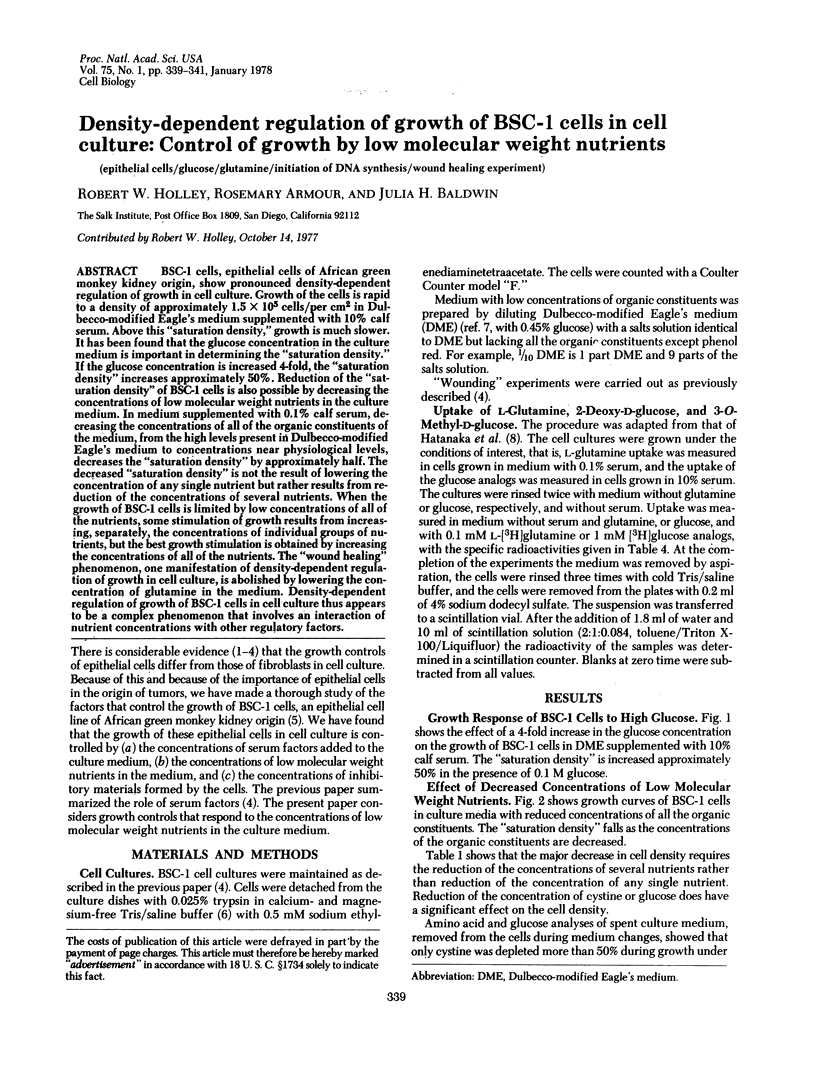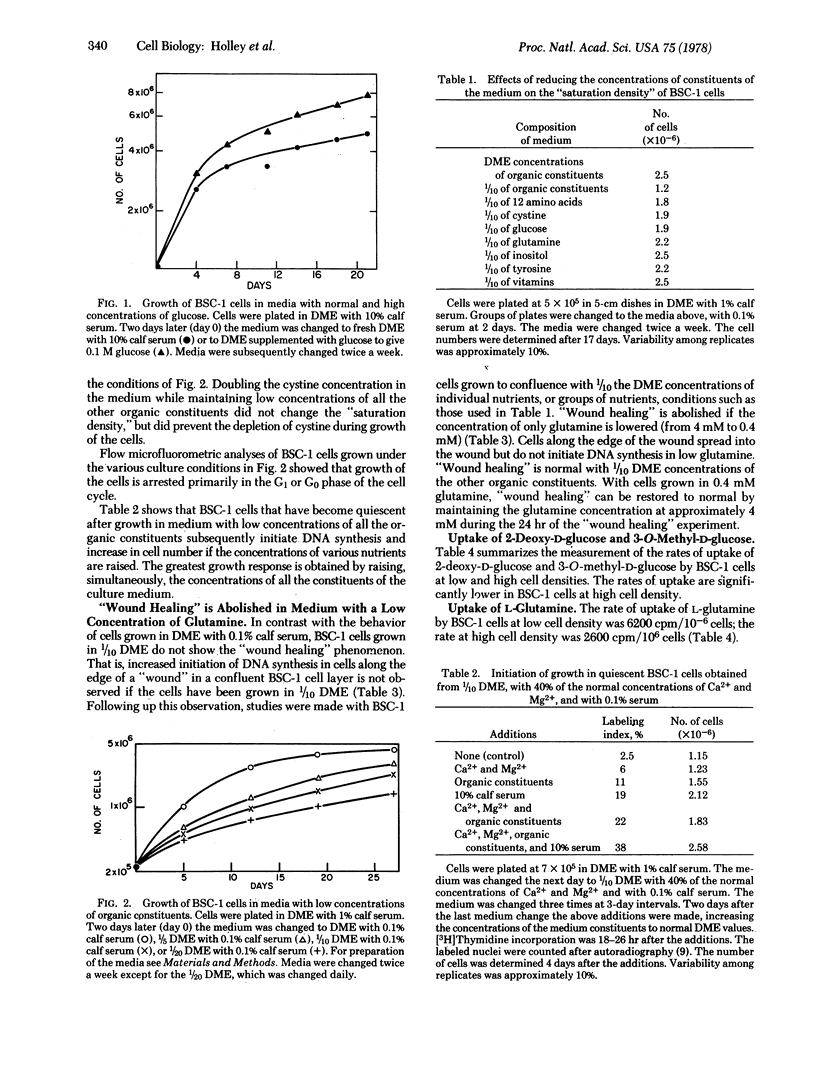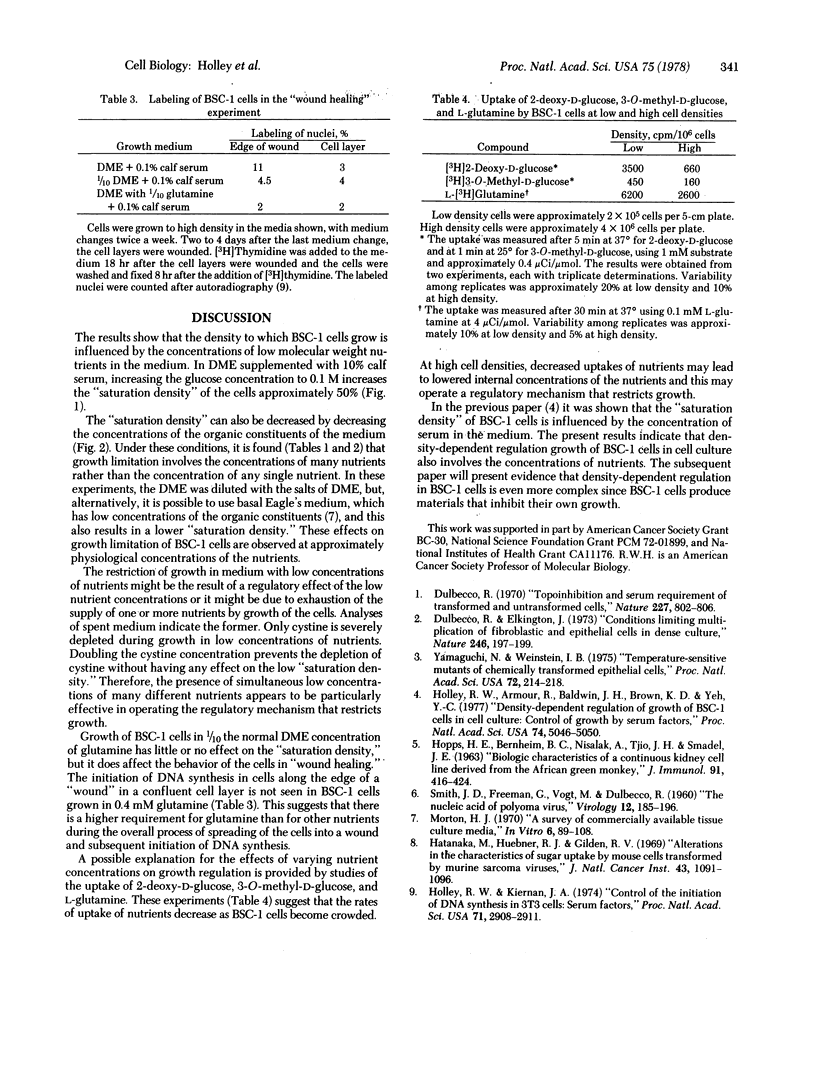Abstract
BSC-1 cells, epithelial cells of African green monkey kidney origin, show pronounced density-dependent regulation of growth in cell culture. Growth of the cells is rapid to a density of approximately 1.5 × 105 cells/per cm2 in Dulbecco-modified Eagle's medium supplemented with 10% calf serum. Above this “saturation density,” growth is much slower. It has been found that the glucose concentration in the culture medium is important in determining the “saturation density.” If the glucose concentration is increased 4-fold, the “saturation density” increases approximately 50%. Reduction of the “saturation density” of BSC-1 cells is also possible by decreasing the concentrations of low molecular weight nutrients in the culture medium. In medium supplemented with 0.1% calf serum, decreasing the concentrations of all of the organic constituents of the medium, from the high levels present in Dulbecco-modified Eagle's medium to concentrations near physiological levels, decreases the “saturation density” by approximately half. The decreased “saturation density” is not the result of lowering the concentration of any single nutrient but rather results from reduction of the concentrations of several nutrients. When the growth of BSC-1 cells is limited by low concentrations of all of the nutrients, some stimulation of growth results from increasing, separately, the concentrations of individual groups of nutrients, but the best growth stimulation is obtained by increasing the concentrations of all of the nutrients. The “wound healing” phenomenon, one manifestation of density-dependent regulation of growth in cell culture, is abolished by lowering the concentration of glutamine in the medium. Density-dependent regulation of growth of BSC-1 cells in cell culture thus appears to be a complex phenomenon that involves an interaction of nutrient concentrations with other regulatory factors.
Keywords: epithelial cells, glucose, glutamine, initiation of DNA synthesis, wound healing experiment
Full text
PDF


Selected References
These references are in PubMed. This may not be the complete list of references from this article.
- Dulbecco R., Elkington J. Conditions limiting multiplication of fibroblastic and epithelial cells in dense cultures. Nature. 1973 Nov 23;246(5430):197–199. doi: 10.1038/246197a0. [DOI] [PubMed] [Google Scholar]
- Dulbecco R. Topoinhibition and serum requirement of transformed and untransformed cells. Nature. 1970 Aug 22;227(5260):802–806. doi: 10.1038/227802a0. [DOI] [PubMed] [Google Scholar]
- HOPPS H. E., BERNHEIM B. C., NISALAK A., TJIO J. H., SMADEL J. E. BIOLOGIC CHARACTERISTICS OF A CONTINUOUS KIDNEY CELL LINE DERIVED FROM THE AFRICAN GREEN MONKEY. J Immunol. 1963 Sep;91:416–424. [PubMed] [Google Scholar]
- Hatanaka M., Huebner R. J., Gilden R. V. Alterations in the characteristics of sugar uptake by mouse cells transformed by murine sarcoma viruses. J Natl Cancer Inst. 1969 Nov;43(5):1091–1096. [PubMed] [Google Scholar]
- Holley R. W., Armour R., Baldwin J. H., Brown K. D., Yeh Y. C. Density-dependent regulation of growth of BSC-1 cells in cell culture: control of growth by serum factors. Proc Natl Acad Sci U S A. 1977 Nov;74(11):5046–5050. doi: 10.1073/pnas.74.11.5046. [DOI] [PMC free article] [PubMed] [Google Scholar]
- Hollwy R. W., Kiernan J. A. Control of the initiation of DNA synthesis in 3T3 cells: serum factors. Proc Natl Acad Sci U S A. 1974 Jul;71(7):2908–2911. doi: 10.1073/pnas.71.7.2908. [DOI] [PMC free article] [PubMed] [Google Scholar]
- Morton H. J. A survey of commercially available tissue culture media. In Vitro. 1970 Sep-Oct;6(2):89–108. doi: 10.1007/BF02616112. [DOI] [PubMed] [Google Scholar]
- Yamaguchi N., Weinstein I. B. Temperature-sensitive mutants of chemically transformed epithelial cells. Proc Natl Acad Sci U S A. 1975 Jan;72(1):214–218. doi: 10.1073/pnas.72.1.214. [DOI] [PMC free article] [PubMed] [Google Scholar]


